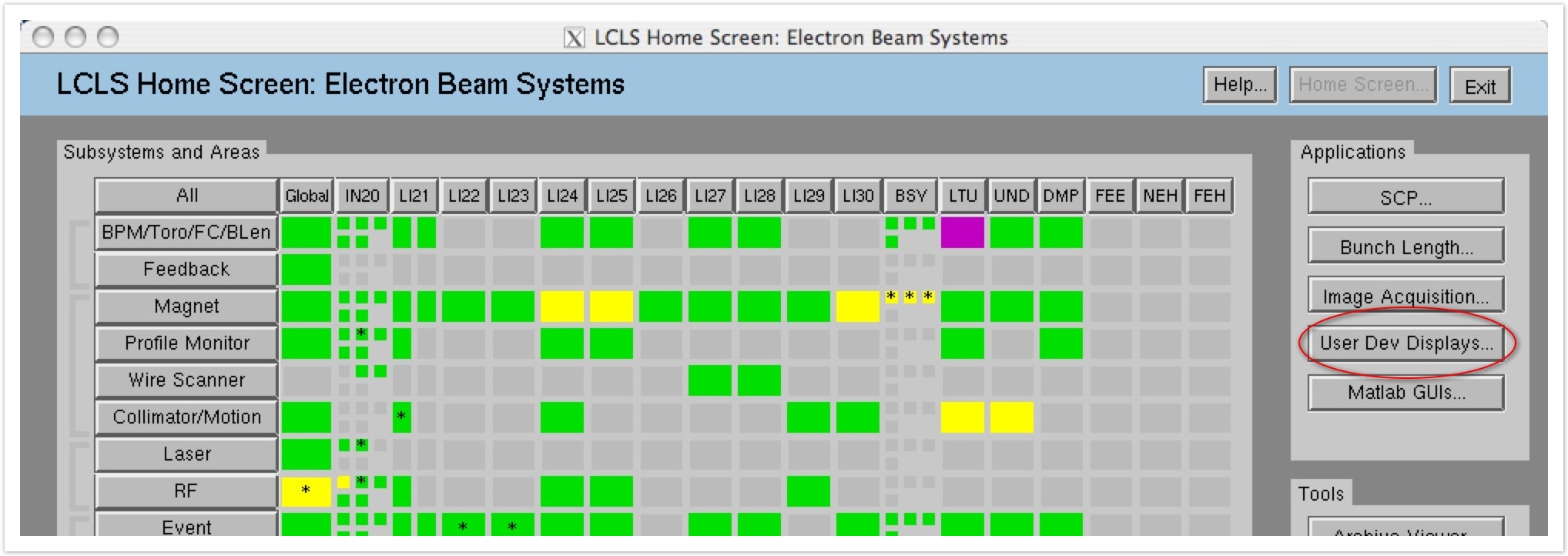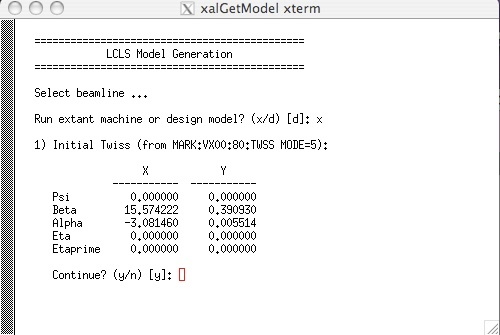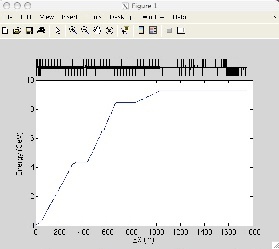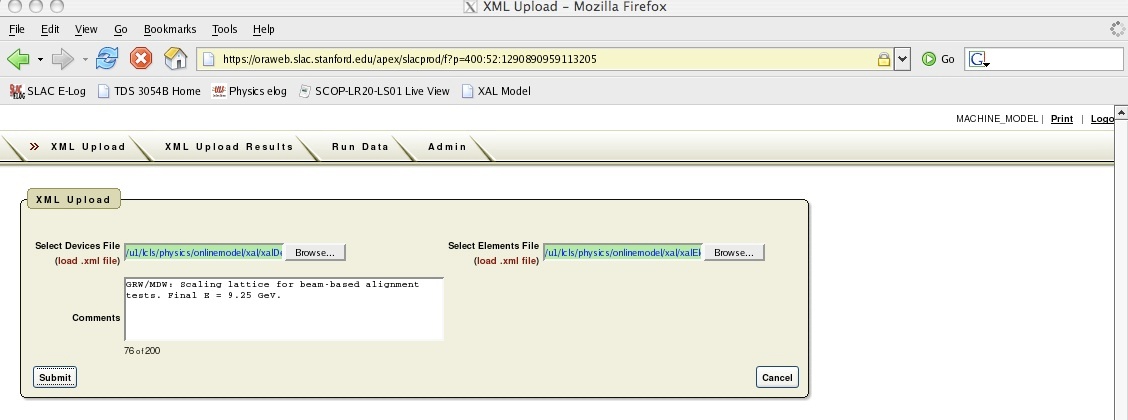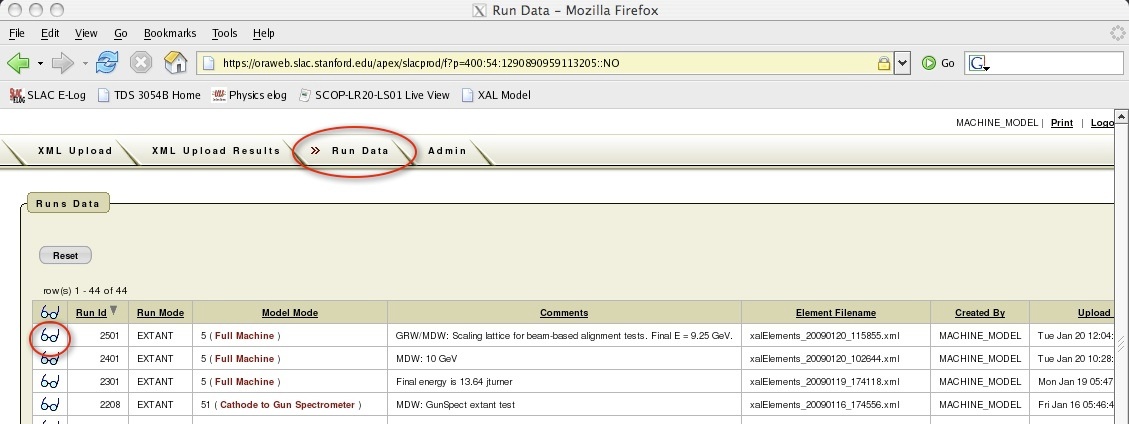...
- Select a beamline to be modelled
- Decide whether to run extant or design model
- If "extant", run LEM lite, to check energy profile
- Run the XAL model (can take 30s - 1 minute). Check resulting energy.
Wiki Markup - Run the XAL XML Writer (to create the model upload file)
- Upload the model to the database. Password for upload is here.
Note: there is no "back" facility. Just abort (ctrl-c to get to the matlab prompt, and start over).
| Anchor | ||||
|---|---|---|---|---|
|
This procedure runs through what you have to do to run a new model whose output will be used by LCLS applications. Click on any of the thumbnail images for a larger view.
From lclshome, select User Dev Displays panel.
Run one of the matlab scripts xalRunModel or xalGetModel
*xalRunModel* simply runs the model and creates the upload files
*xalGetModel* is as xalRunModel, but additionally returns ("gets") the model data to your matlab session. It also creates model plots.
Either of these buttons will start the corresponding matlab script...
... which immediately prompt for you to *Select a beamline* :
\\
The following is a run-through of running xalGetModel for the Extant machine. [Click here to see the full transcript of this example ].
The procedure is asWiki Markup From lclshome -> User Dev Displays panel. !image:lclshomeUserDev.jpg|thumbnail!Wiki Markup follows:
- For example, select "Cathode to Dump" (as shown in the example above). This runs the LCLS "Full Machine" model, from the LCLS Cathode to the main Dump. See Why are all models from Cathode to some location.
Wiki Markup *Select
whether
to
"Run
extant
machine
or
design
model?
(x/d)
\[d\]:*".
Hit
x
or
d,
and
RETURN.
Running the
Running the "design"model
(choice
"d")
causes
the
XAL
model
to
be
run
with
the
element
setpoint
values
in
the
model
input
files.
Those
design
setpoint
values
are,
[to
the
extent
possible,
identical
to
the
MAD
design|#modeldiffs].
Running
the
"extant"
model
(choice
"x")
will
cause
the
model
execution
to
first
replace
the
design
values
of
beamline
devices,
with
the
actual
readback
values,
as
acquired
through
EPICS
and
AIDA,
prior
to
running
the
envelope
tracker.
ThatThat is,
"extant"
is
equivalent
to
what
was
called
"DATABASE"
in
the
SLC
modelling
system;
it
describes
the
extant
machine
at
the
time
the
model
is
run.
!image:xalGetModelextant|thumbnail!*Stages
of
running
the
(extant)
model
are
as
follows:*
unmigrated-wiki-markup*1)
"Initial
Twiss"*
is
displayed.
Check
the
initial
conditions
which
will
be
used
for
the
model
run.
These
are
presently
taken
from
the
SLC
marker
point
80.
You
can
check
these
at
any
time
with
AIDAWeb
([MARK:VX80:80//twiss
the
values
are
Energy
(GeV),
psix,
betax
(m),
alphax
,
etax
(m),
etax',
psiy,
betay
(m),
alphay,
etay
(m),
etay')
!image:extantinitconditions.jpg|thumbnail! If these appear fine, then confirm to continue.
If these appear fine, then confirm to continue.*2) "Run LEM 'Lite'"*. This will calculate and display the fudge factors and predicted energy. When it has completed, _check in particular that the final energy at the undulator_ (see Energy
comlumncolumn, and the row of output labelled "BSY") is reasonable, e.g. 9.25 GeV.
If energy appears fine, then confirm to continue.
*3) "Run XAL machine model."* This can take up to a minute to execute, so please be patient. When it has completed, if you ran xalGetModel, you should get 3 plots - the dispersion, betas, and energy vs Z. The plots may overlap, and the energy plot is on the bottom, so move the others to check it.
- 4) "Create MAD patch file". This stage is always entered, you don't need to do anything. It only takes a moment to create these.
Wiki Markup "Create
and
upload
XML
model
files
to
Oracle?
(y/n)
\[n\]:
"
If
it
all
looks
good,
and
you
want
to
upload
to
Oracle,
say
"y".
5) "Run XML writer." If you said "y" to create the upload files, you'll now see "Run XML writer." This is where the file containing the model results to be uploaded to Oracle, is created. This also takes half a minute or so.
When it has completed, you should see that 3 files have been created: E.g.Code Block /u1/lcls/physics/onlinemodel/xal/xalElements_20090120_115855.xml created /u1/lcls/physics/onlinemodel/xal/xalDevices_20090120_115855.xml created /u1/lcls/physics/onlinemodel/xal/xalModel_20090120_115855.mat created
- Upload the XAL model online on the web. See next section.
The last part of xalGetModel gives some tips of uploading. It remins you where to find the model files in the browser, and the URL of this help. See next the section of help with uploading the model files.
| Anchor | ||||
|---|---|---|---|---|
| ||||
| Anchor | ||||
|
...
At the end of running the model, xalGetModel or xalRunModel should have launched a Firefox browser, open at the web page you use to upload the model into Oracle. The Firefox page should look like this:
The password for user name MACHINE_MODEL, is recorded in the physics logbook entry /lclselog/data/2009/02/06.01
If you do NOT see this page (and unfortunately, sometimes Firefox If you do NOT see this page (and unfortunately, sometimes Firefox does fail to start at the right page) you can use the "XAL Model" tab (see picture) in Firefox to take you to there.
You can log into the web application at any time at the URL: https://oraweb.slac.stanford.edu/apex/slacprod/f?p=400![]() . (See note on supported hosts) You might want to do this to inspect the data
. (See note on supported hosts) You might want to do this to inspect the data
The password for user name MACHINE_MODEL, is recorded in the physics logbook entry /lclselog/data/2009/02/06.01
The procedure for uploading the model files into Oracle:
procedure for uploading the model files into Oracle:
Once you're in the web application Once you're in the web application you should see "Select Device File" and "Select Elements File". These 2 files (of the 3) created by the above model running procedure must be uploaded to Oracle in unison. When a file has been entered for BOTH of these, you can hit "Submit" at the bottom of the dialog screen to start the process of Upload into Oracle.
- Select the Devices file.Device File
Hit the "Select Device File" button. You can either enter a full filename by hand, or use the filebrowser, to browse to /mccfs2/u1/lcls/physics/onlinemodel/xal/ and select the Devices file you created in the process above. in our example above this files was named "xalDevices_20090120_115855.xml". (Tip: since there are many files in this directory, hit "Last Modified" twice, to sort the files by date, latest first). Select the xalDevices file you created, and hit the Open icon (with a picture of a folder!) in the filebrowser dialog to make the selection. (It's a bit confusing using the word "Open" to mean "Select" - talk to Oracle about that - they went cheap and used the firefox file selection widget, designed for selecting a file to open, but they use it to mean "select"). - Select the Elements file.File
Hit the "Select Elements File" button. The filebrowser should open at the right directory - amazing! Hit "Last Modified" twice to sort the files again, and click on the xalElements file you created in step2.2.5 above. Hit "Open".
(You do not need to upload the xalElements file at all). - Comments.
Enter a comment. Please include 2 items in your comment:- Your name, nickname, mark, catchphrase, or other distinguishing refrain from which your personal guilt can be established.
- The Energy at the undulator predicted in step
2.2.3 above!
*Submit*.
When you are finished, the screen should look something like this:Hit the
Wiki Markup "Submit" button.
The
time
to
upload
is
about
1
minute!
Note
that
additional
time
is
presently
spent
creating
the
screen
which
echos
the
upload
data,
but
in
fact
the
model
data
is
available
for
use
as
soon
as
you
see
the
XML
UplodUpload Results
table:
!image:XMLUploadResults.jpg|thumbnail!
Review the model data.
Hit the "Run Data" tab to review the uploaded results of any model which has been uploaded, including the last. Hit the little spectacles icon next to a model upload to view the model parameters of each element calculated as part of that model.
This interface takes a while to load the data, but it can do it for any uploaded model.
Alternatively, use AIDA to check the Rmats of the model elements for the latest upload.
AIDA Model QueriesAnchor model model
Aida Query | Description |
|---|---|
Latest Design Full Machine (Cathode to Dump) model Rmats for all devices | |
Latest Design Cathode to Gun Spectrometer model Rmats for all devices | |
Latest Design Cathode to 135 Mev Spectrometer model Rmats for all devices | |
Latest Design Cathode to 52 line model Rmats for all devices | |
Latest Extant (from actual device settings) Full Machine (Cathode to Dump) model Rmats for all devices | |
Latest Extant (from actual device settings) Cathode to Gun Spectrometer model Rmats for all devices | |
Latest Extant (from actual device settings) Cathode to 135 Mev Spectrometer model Rmats for all devices | |
Latest Extant (from actual device settings) Cathode to 52 line model Rmats for all devices |
Model Notes
| Anchor | ||||
|---|---|---|---|---|
|
...
Update the AIDA Directory service
This section is included for completeness. It is NOT now normal to run this procedure after every model upload, since new devices are seldom added, so please don't bother! Also, Elie has written an automatic procedure to replace this, so we don't have to do it by hand.
Having uploaded a new model, we have to Having uploaded a new model, we have to tell Aida to update its database of the names of XAL modelled devices. We will teach first aidadev, then aidaprod databases. These are, respectively, the Oracle usernames (ie subschema) of the Aida directory services used on the aida development and production networks.
Log into an AFS Solaris machine like tersk02, and set up the cdsoft environment
| Code Block |
|---|
ssh -l<your-username> tersk09
tersk> source /afs/slac/g/cd/soft/dev/script/ENVS.csh
|
Enter sqlplus for user AIDADEV on database SLACPROD (SLACPROD will be set by sourcing ENVS.csh above).
| Code Block |
|---|
sqlplus AIDADEV/<aidadbpassword>
|
...
aida_xal_names_update takes an optional parameter, to specify whether or not to set the service-id to 202 of names it finds to be already in the aida directory. The default (or "N") is not to set the service-id (that is, leave names which are in both the SLC namespace and EPICS name, assigned to the SLC modelling environment (service id 63). If given, and valued "Y", all names modelled by XAL will be assigned to the XAL model service id (202). That is, while we're testing XAL, use the default; when we're sure about XAL, with an EXTANT machine model, and a plan for what to do when devices for like the end station need model, then use Y to switch all modelling of those devices over to XAL.
| Code Block |
|---|
SQL> exec aida_xal_names_update [Y];
PL/SQL procedure successfully completed. <-- you should see this
|
...
You can see which names are assigned to the XAL model server by AIDA, use the following sql script
| Code Block |
|---|
SQL> @show_IA_given_serviceid 202
|
Now go over and update the AIDAPROD names too (don't wait, all names should be in sync), run aida_all_changes again, and verify the names added again.
| Code Block |
|---|
SQL> connect aidaprod/<aidadbpassword>
Connected.
SQL> exec aida_xal_names_update [Y];
SQL> @show_IA_given_serviceid 202
|
...
https://seal.slac.stanford.edu/aidaweb/modelling.jsp
Developers Guide
At the time of writing (31/Jul/08), Elie's upload parser has some restrictions:
Syntax and constraints of the modelOutput xml files:
...
